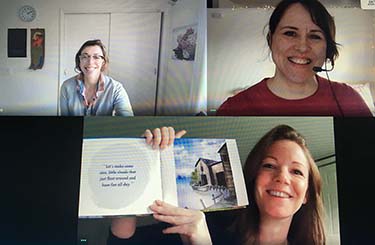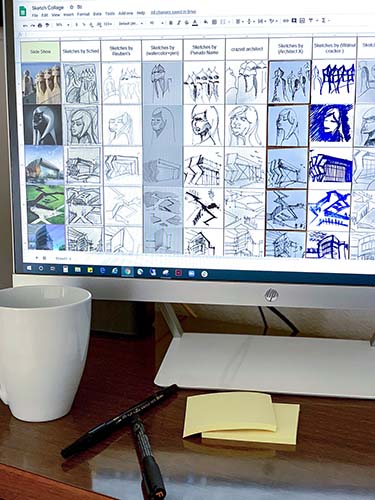|
Subscribe / Renew |
|
|
Contact Us |
|
| ► Subscribe to our Free Weekly Newsletter | |
| home | Welcome, sign in or click here to subscribe. | login |
Architecture & Engineering
| |
 |
March 4, 2021
How to keep the creative spark in a virtual world
Weber Thompson

Hatch
|
As COVID-19 continues to rage on, it’s clear that many of us will continue to work in some sort of remote fashion for the foreseeable future. Many companies have even announced plans to allow their employees to work remotely indefinitely. Perhaps what’s more surprising is that although we have a year of experience under our belts, we’re still discovering just how much we have to learn about working from home.
During 2020 I was faced with helping my team at Weber Thompson find ways to modify our collaborative approach to design while working remotely. In June, I sent a survey to AEC and adjacent industry professionals to gather feedback about how our industry has adapted to remote work. After sharing the results with my colleagues last fall, we hosted a series of firm-wide discussions about what’s working and what’s not. It turns out there’s still plenty of room for improvement.
Through this research, my own experiences over the past year, and our recent discussion series, I’ve compiled six considerations for maintaining a firm culture that promotes growth, collaboration, and communication while maximizing creative output.
• Take time to connect. You heard it throughout 2020: We have a loneliness problem. One of the many impacts of COVID-19 has been a lack of authentic human connection. It is critical to take time at the start of your virtual meetings to connect with your colleagues. Spend a few minutes doing some stretching (seriously!), sharing recommendations for great movies, or talking about what you made for dinner last night. Sharing experiences that aren’t strictly about work can help your team feel connected. There’s a positive impact on creative output too: many of my survey participants noted that warm-up exercises help prepare their brains for creative work.
At Weber Thompson, my marketing team has 15- to 30-minute “stand-up” meetings to start each day while working remotely. We share what we’re watching on Netflix or discuss the latest news, but also talk through our workload and priorities for the day. Sometimes we even use the time to brainstorm ideas for our next project.
• Plant creative seeds. Cross-pollination between teams provides an essential spark for creative ideas and unfortunately, it is nearly impossible to replicate in a remote work environment. If you care about nurturing a creative workplace, you will have to be intentional. Consider hosting all-office design charrettes, share thought-provoking emails with your team, make time for “fun” creative exercises, or simply invite someone on another project team to join your Zoom brainstorm session to provide a fresh perspective. After all, variety is the spice of life and I’ve found most people are happy to jump into a Zoom call to share their ideas with a different team when asked to do so.
Here is an easy idea: At those daily meetings I mentioned, we start with a 5-minute sketch session. It’s simple: we pick a prompt, someone plays a song, and our markers and pencils get moving. It’s a kind of creative meditation that grounds each day and prepares us to use all the parts of our brain. As a bonus, it’s fun! For one of my team members, it was the most beloved part of 2020.
• Invest in tools for collaboration. I heard pleas for better project management and clarity of communication in many survey responses. Managing a fully remote team is much different than sitting together in an open-office pod, so project managers must be intentional about new processes and methods.
It can be tempting to think that creative work results from an organic process. While this is sometimes true, in our industry we are ruled by deadlines, budgets and stakeholder approval processes. A complex web of conversations, emails and phone calls are necessary to make our projects possible. Teams need a system to make sense of it all and PM’s are at the center of this work. Ask around, test out tools, and when you find something that works, invest the time and money into configuring it for your team. Slack, Asana, Trello, Teams, Miro, Mural, Monday —countless tools for task management and creative collaboration were mentioned in my survey responses. Even after we return to whatever the new ‘normal’ is, online tools will continue to contribute to our work lives in the future, and investments made now will certainly pay off later.
On the flip side — don’t shy away from low-tech tools. Sketching on sticky notes and holding them up to your camera can work just as well as an online whiteboard tool. Tailor your tool to your audience and the needs of your team and remember the KISS mnemonic: keep it simple, silly.
• Productivity doesn’t equal creativity. While many survey participants noted an increase in productivity due to fewer daily interruptions, many also indicated a drop in creativity. While we’re maintaining our work output, we’re not maximizing creativity. If you manage creatives, find out what they need to generate their best ideas from home. You might just find out that your star designer works alongside a roommate who has Zoom meetings all day which impedes her ability to focus, so she prefers to design at night. Or perhaps her internet connection has slowed her workflow to a crawl. Find out what might be affecting your team and make adjustments accordingly.
• Embrace flexibility and provide structure. I received countless survey responses praising the benefits of flexibility. Everyone has a slightly different cocktail of at-home factors: kids trying to learn remotely, pets, roommates, spouses, parents who need caretaking, small spaces, shared spaces, technology issues, bad internet connections…the list goes on and on. If we have learned anything over the last year, it’s to have empathy. We’re all doing our best to get our work done while making time for the other things in our lives that make us whole humans. However, many of us also need deadlines, team meetings, and managers to hold us accountable. If you manage creatives, they are counting on you to set the structure so they can do what they do best: creative output.
• Foster mentorship. As firms have adapted organically to remote work, many internal programs have fallen by the wayside. Professional development and mentorship of junior staff has taken a back burner to the myriad pressing concerns senior staff face each day. Unfortunately, this oversight can result in stunted professional growth and may ultimately cause some young professionals to leave the industry. Investing in your staff now will pay dividends well into the future.
If your firm does not have the resources to create a mentorship program, look for outside resources. For example, through the Seattle chapter of the Society for Marketing Professional Services, I have been mentoring a fellow marketer for the past year. We have monthly one-hour phone calls to talk through challenges and share advice. Recently she told me that the program has been so valuable, she’s not sure she could have survived the past year without it.
While we can’t necessarily verbalize exactly why, we know that seeing our coworkers in a three by four grid on our laptop just doesn’t spark our imaginations the way an in-person meeting would. We’re forging ahead, but we’re not necessarily optimizing our creative potential. With some care and attention to your company and team’s creative culture, you just might be able to generate as many fantastic ideas over Zoom as you can in person. In fact, the future of our industry just might depend on it.
Erin Hatch is senior associate and marketing director at Weber Thompson.
Other Stories:
- The future of resilient commercial real estate
- Here are the 3 principles of renovation
- Not all feasibility studies are created equal
- Are American shopping malls boxed-in?
- Green Lake Community Center aims for inclusivity
- It’s the end of the grocery store (as we know it)
- What if you can’t dig your way out of a brownfield cleanup?
- The role of ventilation and healthy air
- Influencing human scale, creating a sense of place
- 4 Living Buildings: collaborative, courageous, open-minded learning
- Parking garages: rethinking your front door
- How A/E firms can increase proposal success in 2021
- Workplace wellness through technology
- Foundations for healthy and sustainable urban places
- A changed workforce and the implications for workplaces and cities




